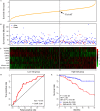Establishment of a nine-gene prognostic model for predicting overall survival of patients with endometrial carcinoma
- PMID: 29665298
- PMCID: PMC6010780
- DOI: 10.1002/cam4.1498
Establishment of a nine-gene prognostic model for predicting overall survival of patients with endometrial carcinoma
Abstract
Endometrial carcinoma (EC) is the most common malignant tumor of the female genital tract in developed countries. The prognosis of early stage EC is favorable, but a subset faces high risk of cancer progression or recurrence. EC has a poor prognosis upon progression to advanced or metastatic stages. Therefore, our goal is to build a robust prognostic model for predicting overall survival (OS) in EC patients. In this study, 1571 genes were identified as being associated with OS based on genomewide expression profiles using a training dataset. Kyoto Encyclopedia of Genes and Genomes enrichment analysis revealed that these genes were involved in various cancer-related signaling pathways. Nine signature genes were further selected using stepwise selection, and their potential role in the development of EC was demonstrated by performing differential expression analysis between EC and normal uterine tissues. A prognostic model that aggregated these nine signature genes was ultimately established and effectively divided EC patients into two risk groups. OS for patients in the high-risk group was significantly poorer compared with that of the low-risk group. This nine-gene model was subsequently validated and evaluated using the TCGA dataset and shown to have a high discriminating power to distinguish EC patients with an elevated risk of mortality based on the FIGO staging system and other prognostic factors. This study provides a novel prognostic model for the identification of EC patients with elevated risk of mortality and will help to improve our understanding of the underlying mechanisms involved in prognostic EC factors.
Keywords: Endometrial carcinoma; genomewide expression profiles; overall survival; prognostic model; signature gene.
© 2018 The Authors. Cancer Medicine published by John Wiley & Sons Ltd.
Figures




Similar articles
-
Establishing a Prognostic Signature Based on Epithelial-Mesenchymal Transition-Related Genes for Endometrial Cancer Patients.Front Immunol. 2022 Jan 14;12:805883. doi: 10.3389/fimmu.2021.805883. eCollection 2021. Front Immunol. 2022. PMID: 35095892 Free PMC article.
-
Significance of a PTEN Mutational Status-Associated Gene Signature in the Progression and Prognosis of Endometrial Carcinoma.Oxid Med Cell Longev. 2022 Feb 23;2022:5130648. doi: 10.1155/2022/5130648. eCollection 2022. Oxid Med Cell Longev. 2022. PMID: 35251475 Free PMC article.
-
High expression of S100A2 predicts poor prognosis in patients with endometrial carcinoma.BMC Cancer. 2022 Jan 18;22(1):77. doi: 10.1186/s12885-022-09180-5. BMC Cancer. 2022. PMID: 35042454 Free PMC article.
-
Non-Coding RNAs as Prognostic Markers for Endometrial Cancer.Int J Mol Sci. 2021 Mar 19;22(6):3151. doi: 10.3390/ijms22063151. Int J Mol Sci. 2021. PMID: 33808791 Free PMC article. Review.
-
Prognostic role of C-reactive protein in patients with endometrial cancer: a meta-analysis.Biomark Med. 2024;18(6):279-289. doi: 10.2217/bmm-2023-0810. Epub 2024 Apr 19. Biomark Med. 2024. PMID: 38639733 Review.
Cited by
-
Tumor mutation burden in connection with immune-related survival in uterine corpus endometrial carcinoma.Cancer Cell Int. 2021 Jan 28;21(1):80. doi: 10.1186/s12935-021-01774-6. Cancer Cell Int. 2021. PMID: 33509222 Free PMC article.
-
Prognostic Potential of Alternative Splicing Markers in Endometrial Cancer.Mol Ther Nucleic Acids. 2019 Dec 6;18:1039-1048. doi: 10.1016/j.omtn.2019.10.027. Epub 2019 Nov 2. Mol Ther Nucleic Acids. 2019. PMID: 31785579 Free PMC article.
-
BUB1, BUB1B, CCNA2, and CDCA8, along with miR-524-5p, as clinically relevant biomarkers for the diagnosis and treatment of endometrial carcinoma.BMC Cancer. 2023 Oct 18;23(1):995. doi: 10.1186/s12885-023-11515-9. BMC Cancer. 2023. PMID: 37853361 Free PMC article.
-
The landscape and prognostic value of immune characteristics in uterine corpus endometrial cancer.Biosci Rep. 2021 Apr 30;41(4):BSR20202321. doi: 10.1042/BSR20202321. Biosci Rep. 2021. PMID: 33782686 Free PMC article.
-
Clinical and Expression Significance of AKT1 by Co-expression Network Analysis in Endometrial Cancer.Front Oncol. 2019 Nov 6;9:1147. doi: 10.3389/fonc.2019.01147. eCollection 2019. Front Oncol. 2019. PMID: 31781484 Free PMC article.
References
-
- Ferlay, J. , Soerjomataram I., Dikshit R., Eser S., Mathers C., Rebelo M., et al. 2015. Cancer incidence and mortality worldwide: sources, methods and major patterns in GLOBOCAN 2012. Int. J. Cancer 136:E359–E386. - PubMed
-
- Siegel, R. L. , Miller K. D., and Jemal A.. 2015. Cancer statistics, 2015. CA Cancer J. Clin. 65:5–29. - PubMed
-
- Kosary, C. L. 1994. FIGO stage, histology, histologic grade, age and race as prognostic factors in determining survival for cancers of the female gynecological system: an analysis of 1973‐87 SEER cases of cancers of the endometrium, cervix, ovary, vulva, and vagina. Semin. Surg. Oncol. 10:31–46. - PubMed
-
- Morice, P. , Leary A., Creutzberg C., Abu‐Rustum N., and Darai E.. 2016. Endometrial cancer. Lancet 387:1094–1108. - PubMed
-
- Zsiros, E. , Tanyi J., Balint K., and Kandalaft L. E.. 2014. Immunotherapy for ovarian cancer: recent advances and perspectives. Curr. Opin. Oncol. 26:492–500. - PubMed
Publication types
MeSH terms
Substances
LinkOut - more resources
Full Text Sources
Other Literature Sources

